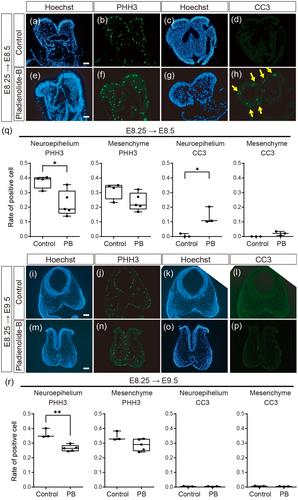Fig. 3 Immunohistochemistry of PHH3 and CC3 in wild-type embryos. (a–d) Frontal sections of control embryos at E8.5 and (e–h) frontal sections of E8.5 embryos exposed to PB at E8.25. (a, c, e, g) Hoechest, (b, f) PHH3, and (d, h) CC3 immunofluorescent signals. (i–l) Frontal sections of control embryos at E9.5 and (m–p) and frontal sections of E9.5 embryos exposed to PB at E8.25. (i, k, m, o) Hoechest, (j, n) PHH3, and (l, p) CC3 immunofluorescent signals. n = 3 for each experiment in (a–h) and (i–p). (q, r) Ratio of PHH3 and CC3 positive cells in the neuroepithelium and mesenchyme in E8.5 (q) or E9.5 (r) embryos of control and PB-exposed at E8.25. For (q) and (r), the cell rates were calculated by the positive cell number per nucleus number in the same area. The dots in (q) and (r) represent individual embryos obtained from at least two control or two PB-treated pregnant mice. *: p < 0.05, **: p < 0.01 (Student's t-test). Scale bar: 50 μm for (a, e) and 100 μm for (i, m).
Image
Figure Caption
Acknowledgments
This image is the copyrighted work of the attributed author or publisher, and
ZFIN has permission only to display this image to its users.
Additional permissions should be obtained from the applicable author or publisher of the image.
Full text @ Birth Defects Res

